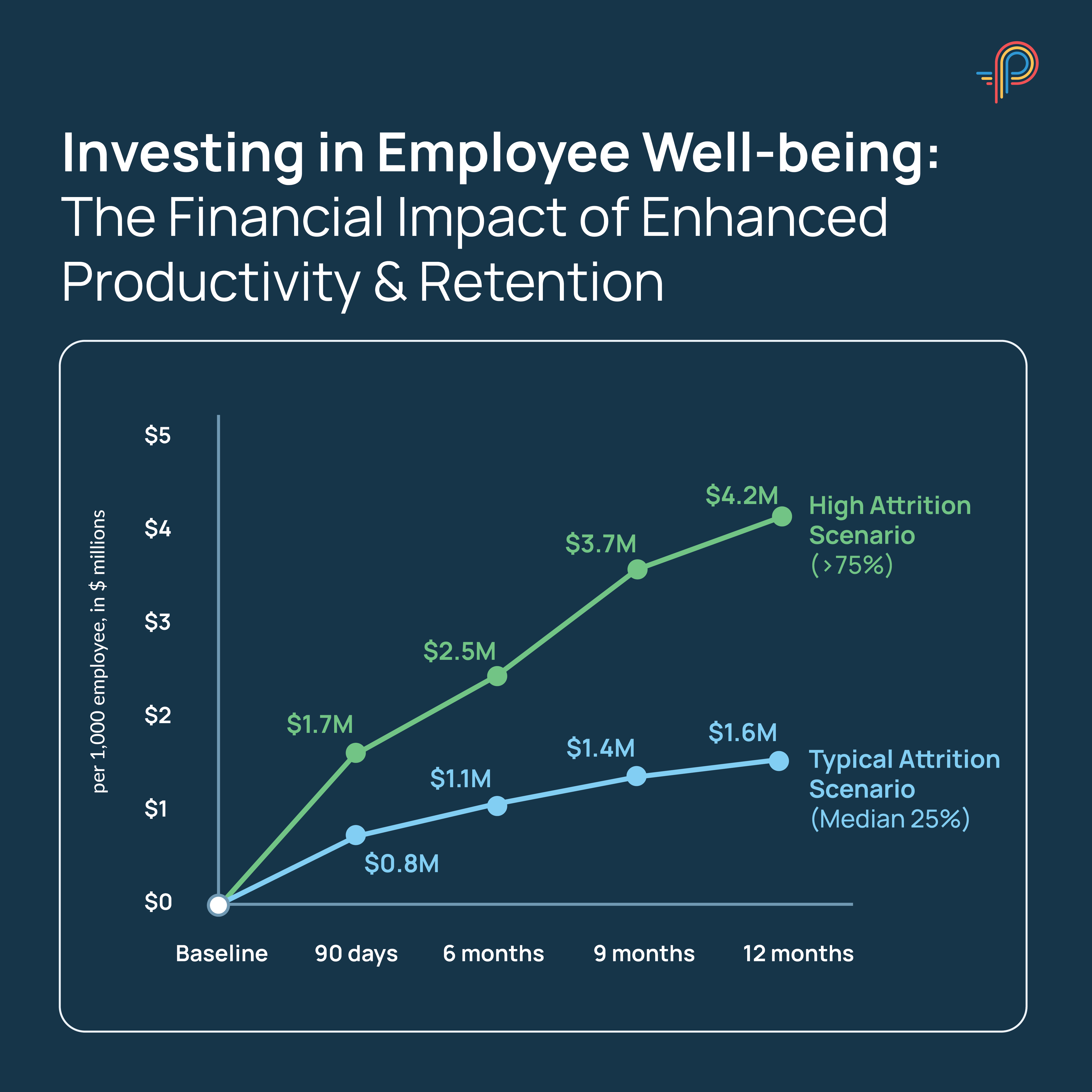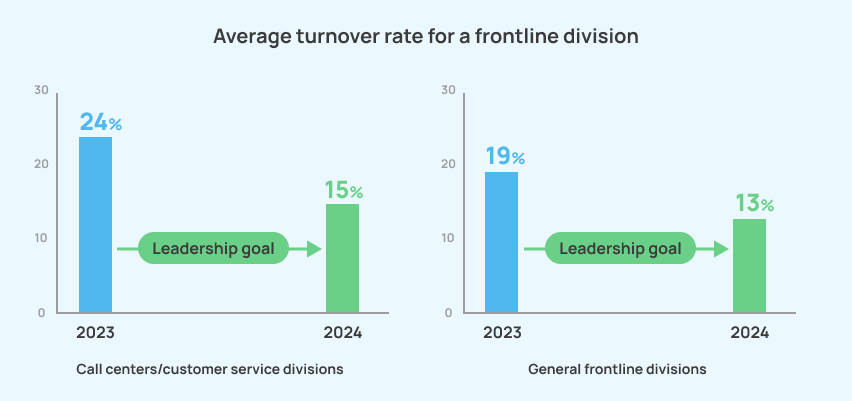When we consider the world of call centers, many might conjure up images of distant offices bustling with activity as representatives from countries like India or the Philippines tackle everything from credit card disputes to insurance inquiries. Surprisingly, though, this industry is still thriving closer to home. According to the Bureau of Labor & Statistics, nearly 3 million dedicated customer service representatives are located in the U.S.

Unlike their international counterparts, US call centers employ mostly part-time employees at lower wages, resulting in high turnover. The US BLS predicts this frontline workforce will decline by 5 percent over the next eight years.
Pathstream has unearthed intriguing insights into the challenge of early attrition, especially within the first 90 days of employment – a period critical to both the employee and the organization. Leveraging external research from COPC and our comprehensive analyses, we discovered that a staggering 70% of all first-year call center attrition occurs in this initial phase. This insight is crucial for business leaders, as the financial impact of this early turnover can be considerable, potentially translating to losses of up to $1.7 million for a division with 1,000 team members.
Understanding these dynamics is key to fostering more resilient and effective call center teams, ultimately enhancing employee satisfaction and organizational success.
Exploring the roots of early attrition in contact centers
Let’s examine what contact center leaders are actually identifying as the root causes of attrition for their frontline teams.
In our pursuit of understanding what’s driving the departure of frontline team members from their roles, we’ve delved into insights shared by leaders in contact centers. The landscape for call center representatives in the United States is one of abundant opportunity, with a steady stream of job postings on LinkedIn and company boards enticing them with the promise of better prospects. 
A seemingly minor upgrade – be it in terms of salary adjustment for inflation, the flexibility of a fully remote role, or enhanced career advancement opportunities – can be a pivotal factor for individuals whose earnings are generally under the $40,000 mark annually, influencing their decision to stay or move on.
According to our market survey taken by Fortune 500 frontline business unit leaders, the average turnover rate for a frontline division in 2023 was approximately 19%. This number is even higher for call centers or customer service divisions at approximately 24% turnover. Leaders hope to get these numbers down to 13% and 15% in 2024. However, most organizations don’t account for the attrition that happens before 90 days, given that these employees haven’t fully been onboarded and trained yet, which infers that this 19% and 24% churn is largely underestimated.
Much of the early turnover is due to ineffective onboarding processes. It’s crucial that call center representatives are thoroughly and thoughtfully prepared for their roles rather than just going through routine procedural exercises and compliance training. Sometimes, they come across new information not clearly communicated in the job description, leading to frustration and their decision to move on. Perhaps the job’s nature, such as being partly hybrid or requiring extensive phone use, wasn’t entirely clear to them. Ensuring that onboarding processes set representatives up for success and provide them with the support they need to excel is crucial for retention.
Traditional methods to combat call center attrition
Many contact center leaders have attempted to solve for turnover more broadly without successfully preventing early attrition within the first 90 days. Often, they overlook these early turnover figures, rationalizing them as an inevitable part of the process to eliminate unsuitable candidates.
Others often lean on familiar retention strategies such as:
- Increasing monetary incentives
- Providing additional benefits
- Increasing transparency on pay raises
- Enhancing workplace flexibility
These strategies aren’t as effective at reducing early turnover, given they don’t actually relate to the problems experienced in the first 90 days, such as ineffective onboarding and mismatches between job descriptions and roles. Given the abundance of similar roles that exist elsewhere, employees will simply go somewhere else before they get too deep into the position.
A New Strategy – building hope and clear career pathways to reduce costs
Our extensive work with frontline employees at Pathstream shows that the most effective strategy to reduce early-stage churn is to give your people hope in their future with you. Organizations can achieve this by creating clearly defined, realistic career pathways. This empowers employees to envision a long-term future with the company and equips them with the knowledge of how to get there.
Three steps to reduce early turnover through career pathways:
- Ensure job descriptions accurately reflect the role responsibilities of your frontline teams
- Map out the internal growth opportunities that exist for Level 1 and 2 employees and what new skills are required to get there
- Have frontline management communicate these career pathways with their employees during the onboarding process
Applying these strategies can lead to substantial savings, especially in high-turnover environments like call centers. Our analysis has shown that the combined costs of hiring, training, and compensation during the initial 90 days amount to approximately $18,000 per frontline employee. So even if you’re only able to retain 5% more call center representatives by introducing attainable career pathways – in a division of 1,000 employees, that’s nearly $1 million in cost savings!
Conclusion
The phenomenon of high turnover within U.S. call centers has reached unprecedented levels, striking most acutely within the initial 90 days of employment. Addressing this challenge requires more than conventional methods; it demands innovative strategies that ignite employee hope and engagement. It’s crucial for leaders in this sector to understand that fostering immediate, tangible career progression opportunities isn’t just a morale booster – it’s a strategic investment.
At Pathstream, we’ve witnessed firsthand the transformative impact of integrating concise, early-stage retention strategies alongside more traditional approaches. The outcome? More vibrant, committed teams, increased call center retention, and significant financial returns.
Elevate your approach to curbing early turnover by embedding career pathways into your operational model. To dive deeper into how these strategies can be tailored to your organization’s unique needs, engage with our team of learning experts at Pathstream. Let us guide you towards fostering an environment where every employee sees a future brimming with potential.
The information in this article has been sourced from various data sources, including a survey targeted at large Fortune 500 contact center leaders, research interviews with contact center leaders, supporting desktop research, and Pathstream’s accumulated subject matter expertise on servicing this buyer persona.
Pathstream is a mission-driven organization founded on the premise that tremendous, unrealized economic and human potential exists within an organization’s frontline workforce. We are dedicated to empowering employees and supervisors to thrive in their careers by providing motivation, support, and the necessary skills to achieve their goals. Our innovative platform integrates personalized professional coaching, practical skill-building programs, and comprehensive career pathing – enabling organizations to provide effective, end-to-end support for their frontline workforce while benefiting from improved retention and in-role performance.
Was this helpful?
Thanks! What made it helpful?
How could we improve this post?






